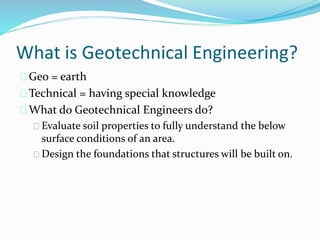The 15-Second Trick For Geotheta
The 15-Second Trick For Geotheta
Blog Article
The Buzz on Geotheta
Table of ContentsThe Best Guide To GeothetaGeotheta for BeginnersUnknown Facts About GeothetaGeotheta - QuestionsThe Facts About Geotheta Revealed

They perform website examinations, gather examples, do lab tests, and evaluate data to assess the viability of the ground for building tasks - Consulting Engineers. Based upon their findings, geotechnical engineers provide recommendations for foundation layout, slope stability, retaining structures, and reduction of geotechnical hazards. They work together with various other specialists, such as architects, structural engineers, and building and construction groups, to make sure that geotechnical considerations are integrated into the overall project style and execution
By analyzing the actions and properties of dirt and rock, they can identify prospective geotechnical threats such as landslides, soil negotiation, or slope instability. Their proficiency assists protect against failures or crashes that might jeopardize lives and home. Here are some thorough obligations and obligations of a geotechnical engineer: Website Examination: Geotechnical designers conduct website examinations to collect data on subsurface problems.
They analyze the information to comprehend the homes and behavior of the dirt and rock, including their strength, permeability, compaction characteristics, and groundwater conditions. Geotechnical Evaluation and Style: Geotechnical engineers examine the information gathered during site investigations to analyze the stability and suitability of the website for construction jobs. They execute geotechnical computations and modeling to review aspects such as bearing ability, settlement, incline stability, side planet pressures, and groundwater circulation.
The Single Strategy To Use For Geotheta
Foundation Layout: Geotechnical designers play a vital duty in designing foundations that can safely support the desired structure. They evaluate the soil problems and lots requirements to figure out the suitable structure kind, such as shallow structures (e.g., grounds), deep foundations (e.g (https://www.brownbook.net/business/52934980/geotheta/)., piles), or specialized methods like soil renovation. They consider elements such as settlement limits, bearing ability, and soil-structure interaction to establish optimum foundation designs
They examine building and construction plans, screen website activities, and carry out field inspections to confirm that the style recommendations are complied with. If unexpected geotechnical concerns arise, they analyze the circumstance and provide recommendations for remediation or changes to the layout. Danger Analysis and Mitigation: Geotechnical engineers assess geotechnical hazards and threats related to the project website, such as landslides, liquefaction, or soil erosion.

Collaboration and Communication: Geotechnical designers work carefully with various other professionals included in a project, such as engineers, structural engineers, and construction groups. Effective communication and cooperation are vital to incorporate geotechnical considerations into the overall task layout and building procedure. Geotechnical designers give technological experience, response queries, and ensure that geotechnical needs are met.
Geotheta Can Be Fun For Everyone
Here are some kinds of geotechnical engineers: Structure Engineer: Foundation designers concentrate on designing and assessing foundations for structures. They assess the soil problems, load needs, and site qualities to identify the most appropriate structure kind and layout, such as superficial foundations, deep foundations, or specialized methods like pile foundations.
They evaluate the variables influencing slope security, such as soil homes, groundwater problems, and incline geometry, and establish methods to stop slope failings and mitigate dangers. Quake Designer: Earthquake designers specialize in examining and designing structures to hold up against seismic pressures. They assess the seismic danger of a website, review dirt liquefaction possibility, and establish seismic style requirements to ensure the safety and durability of structures throughout earthquakes.
They carry out area testing, accumulate examples, and analyze the accumulated information to characterize the soil buildings, geologic formations, and groundwater conditions at a website. Geotechnical Instrumentation Designer: Geotechnical instrumentation designers concentrate on monitoring and determining the behavior of soil, rock, and structures. They mount and maintain instrumentation systems that check elements such as soil settlement, groundwater degrees, incline activities, and architectural variations to evaluate efficiency and offer early warnings of prospective problems.
The Of Geotheta
They conduct tests such as triaxial tests, combination tests, direct shear tests, and leaks in the structure examinations to gather data for geotechnical evaluation and style. Geosynthetics Engineer: Geosynthetics designers concentrate on the layout and application of geosynthetic products, such as geotextiles, geogrids, and geomembranes. They make use of these materials to enhance dirt security, reinforce inclines, offer drain options, and control disintegration.
They tend to be investigative individuals, which suggests they're intellectual, introspective, and curious. They wonder, methodical, logical, analytical, and sensible. Some of them are additionally social, suggesting they're kind, charitable, cooperative, person, caring, practical, compassionate, sensible, and pleasant. Does this noise like you? Take our cost-free profession examination to locate out if geotechnical designer is one of your leading occupation suits.
In the workplace atmosphere, geotechnical designers use specialized software application tools to perform computations, create layouts, and assess information. They prepare records, evaluation project requirements, connect with clients and staff member, and coordinate job activities. The workplace setup offers a favorable environment for study, evaluation, and cooperation with various other experts associated with the project.
Things about Geotheta
They often visit project websites to carry out website examinations, evaluate geotechnical conditions, and gather information for analysis. These check outs entail taking a trip to different areas, find more sometimes in remote or challenging surfaces. Geotechnical engineers may carry out dirt sampling, conduct tests, and screen building activities to make sure that the geotechnical elements of the job are being executed appropriately.
Geotechnical engineers likewise work in specialized geotechnical laboratories. Geotechnical research laboratory engineers function thoroughly in these atmospheres, handling testing tools, running instruments, and recording data.
Report this page